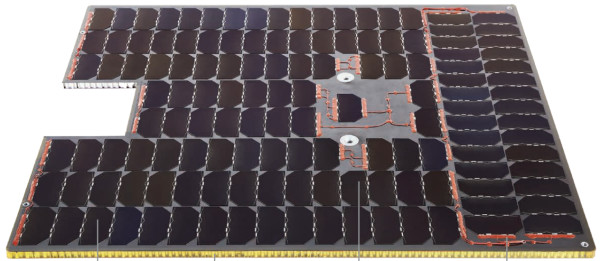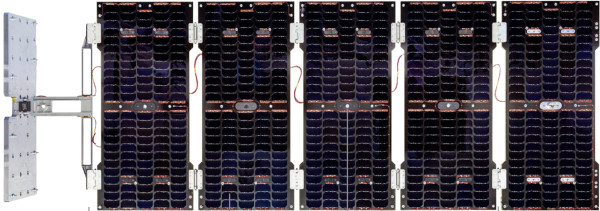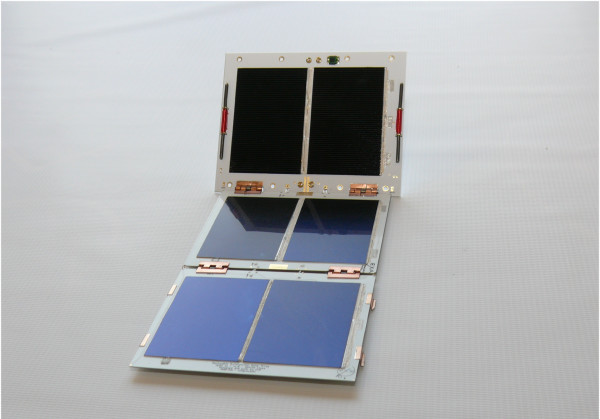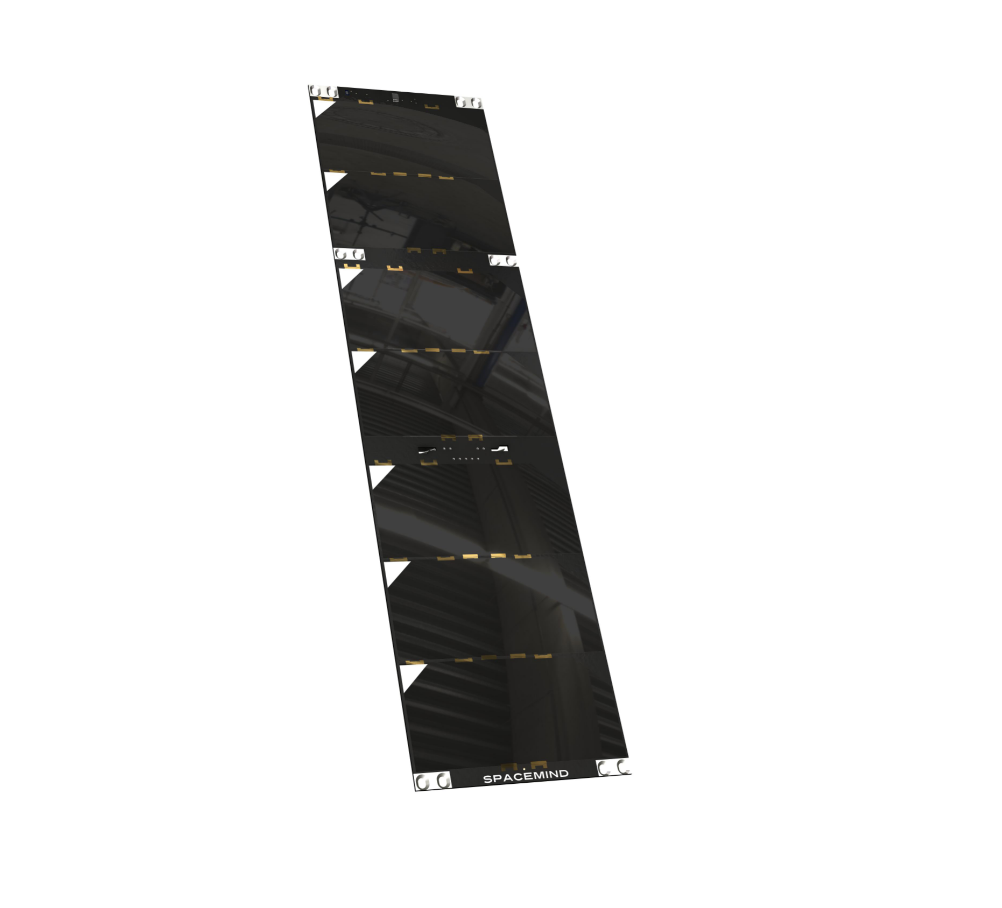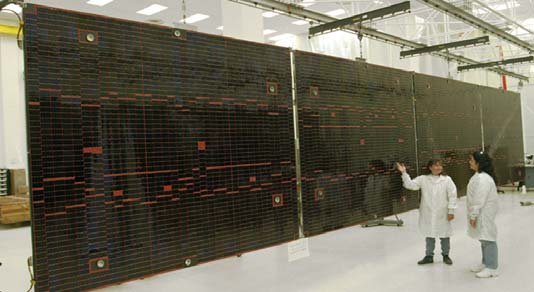In this post we give a brief overview of satellite and CubeSat solar panels and arrays, sharing listings of multiple products available on the global marketplace – if you would like to skip the introductory material and instead get straight to the product listings, please click here.
Unlike larger satellites where the surface area available on the external structures is much greater, CubeSats, nanosatellites and other small satellites have far less volume that can be given to solar panels.
A 1U CubeSat for example will have an area of just 10 cm x 10 cm on each face in order to accommodate a solar panel.
In addition, solar panels can also not be mounted on surfaces that need to accommodate other components, such as planar antennas, optical sensors, camera lenses, and access ports.
In spite of these limitations there are several different solar panels available on the market, featuring a variety of solar cells for space applications, which work with the severe physical restrictions imposed by smallsats and the CubeSat (and smaller) form factor.
Key performance criteria for selecting the right solar panel
Aside from the size of the panels themselves, there are several important criteria to consider when choosing the satellite solar panel or array:
- Generation of energy in accordance with the orbit functioning requirements of the satellite
- Compliance with the voltage and current levels acceptance by the power conditioning and distribution system within the satellite
- Compliance to launch vehicles and the loads specified by launch providers
- Compatibility with the temperature range that the satellite can face during launch and in orbit
- Compatibility with all the materials used within the satellite and the nature of their behavior due to thermal expansion and contraction during launch and orbit
- Reliable actuation for deployment of the panels (there are multiple options available such as flexible joints, shape memory alloys, torsion spring in hinge, coil springs, motors, etc.)
- Ability to withstand physical launch stresses
Alongside the supplier location, heritage and similar commercial factors that influence satellite solar panel costs, these criteria should be used to assess what system will work best for your mission and timescales.

Integration of solar panels with other sub-systems
For a satellite solar panel to work effectively it needs to be successfully integrated into the craft alongside the other equipment in use.
Here are a few tips and tricks on how to integrate a panel efficiently with other sub-systems in order to gain more value than simply generating power:
- To allow easier integration and flexibility while assembling a smallsat, nanosat or CubeSat, solar panels can be efficiently packaged along with other sub-systems, such as structures. A mechanical back plate design, based on aluminium machined alloy, may be used with standard solar panel mounting holes to perform such an integration.
- Sensor packages including an accelerometer, gyroscope, magnetometer, coarse sun sensor and temperature sensor (external and internal) can be integrated into such a design in order to accommodate elements of the attitude control and electrical power system.
- Multiple independent Remove Before Flight (RBF) circuits can be added in different locations (X,Y or Z solar panels) in order to comply with different deployers’ and launch service providers’ requirements.
- It is possible to embed magnetorquers that can be configured to provide different levels of torque and power consumption in order to comply with different mission profiles.
Deployable solar panels and arrays
Traditionally smaller satellites have not had deployable arrays to generate more power for advanced missions or more power-hungry payloads.
Today, due to advances in new technology and electronic minitiarisation, it is possible for smaller satellites to use various deployable solar array solutions.
Such technology typically utilises a ‘hold down and release mechanism’ using a spring-loaded slider that ensures safe and effective hold down functionality for the deployable panels.
The slider is locked by a locking arm system that can be released with a dedicated pin-pusher for deployment.
Satellite solar panels on the global marketplace
In the list below we have rounded up a range of commercially-available satellite solar arrays and panels on the global marketplace for space.
If you require further information on structural or power generation satellite sub-systems we have also published roundups of Electrical Power Systems (EPS) and satellite structures on the global marketplace.
Please note that this list will be updated when new products are added to the marketplace – so please check back for more or sign up for our mailing list to get all the updates.
The 2NDSpace CORE-01 is a 1U lateral solar panel designed for NewSpace applications. It consists of custom interfaces and umbilical connections. The panel has stabilized thermal dissipation architecture. It also consists of ultra triple junction 30% efficient solar cells.
The 2NDSpace CORE-01Z is a 1U top/bottom solar panel designed for NewSpace applications. It consists of ultra triple junction 30% efficient solar cells. The panel has stabilized thermal dissipation architecture. It also has custom interfaces and umbilical connections.
The 2NDSpace CORE-02 is a 2U lateral solar panel designed for NewSpace applications. It consists of ultra triple junction 30% efficient solar cells. The panel has stabilized thermal dissipation architecture. It also has custom interfaces and umbilical connections.
The 2NDSpace CORE-03 is a 3U lateral solar panel designed for NewSpace applications. It consists of custom interfaces and umbilical connections. The panel has stabilized thermal dissipation architecture. It also consists of ultra triple junction 30% efficient solar cells.
The 2NDSpace CORE-06Z is a 6U top/bottom solar panel designed for NewSpace applications. It consists of custom interfaces and umbilical connections. The panel has stabilized thermal dissipation architecture. It also consists of ultra triple junction 30% efficient solar cells.
The 2NDSpace CORE-12 is a 6U/12U lateral solar panel designed for NewSpace applications. It consists of ultra triple junction 30% efficient solar cells. The panel has stabilized thermal dissipation architecture. It also has custom interfaces and umbilical connections.
The 2NDSpace CORE-12Z is a 12U/16U lateral solar panel designed for NewSpace applications. It consists of ultra triple junction 30% efficient solar cells. The panel has stabilized thermal dissipation architecture. It also has custom interfaces and umbilical connections.
The 2NDSpace CORE-16 is a 16U lateral solar panel designed for NewSpace applications. It consists of custom interfaces and umbilical connections. The panel has stabilized thermal dissipation architecture. It also consists of ultra triple junction 30% efficient solar cells.
The DCUBED PowerCube is a deployable 100W Origami Solar Array stowed within a 1U form factor. PowerCube enables extreme power-intensive space missions while requiring only minimal stowed volume during launch. It is one of the smallest, yet powerful solar array solutions on the market. It is easily resettable, easy to use, and readily available as a COTS subsystem.
The DCUBED Body-Mounted Solar Array is designed for average-level power applications in space. It is a cost-efficient power generation solution if power requirements are average and surface area is not limited. The body-mounted solar array also allows for great customization in terms of solar cells as well as mechanical and electrical layout.
The DCUBED Rigid-Deployable Solar Array is designed for satellite applications. It combines both body-mounted and deployable solar arrays. It allows for the best use of available spacecraft surface area for power generation while expanding beyond that once in orbit. DCUBED’s rigid-deployable solar array is a turn-key product, which also includes the mechanical substrate, electrical harnessing, solar cells, hinges, and HDRMs.
Solis+ is a family of Space-grade Solar Arrays meticulously built using high-efficiency (>30%) Triple Junction GaAs Solar Cells to maximise power generation while optimizing both the mass and space considerations. These solar arrays are precision-engineered and manufactured by Dhruva Space to operate in the demanding conditions of space, offering customized power capacities of up to a few kW, with multiple bus configurations that are suitable for larger classes of satellites and spacecraft.
Solis is a family of Spacecraft Solar Arrays by full-stack Space engineering solutions company Dhruva Space built using high-efficiency (>30%) Triple-Junction GaAs Solar Cells to maximise power generation. These solar arrays are specifically engineered and manufactured by Dhruva Space to operate in the Space environment, providing a reliable source of electrical power for various types of satellites and spacecraft.
The DHV Technology 1U CubeSat Solar Panel (DHV-1U Series) is designed for 1U nanosatellites. It can provide power generation for LEO missions and has the capability to operate for at least 3 years in temperatures ranging between -50 ̊C and +125 ̊C. The DHV-1U Series ensures protection against atomic oxygen.
The DHV Technology 2U CubeSat Solar Panel (DHV-2U Series) is designed for 2U nanosatellites. It can provide power generation for LEO missions and has the capability to operate for at least 3 years in temperatures ranging between -50 ̊C and +125 ̊C. It also consists of telemetry data for thermal aspects as well as attitude determination and control. The DHV-2U Series ensures protection against atomic oxygen.
The DHV Technology 3U CubeSat Solar Panel (DHV-3U Series) is designed for 3U nanosatellites. It is also designed to provide power generation for any 3U/6U nanosatellite. It can provide power generation for LEO missions and has the capability to operate for at least 3 years in temperatures ranging between -50 ̊C and +125 ̊C. The DHV-3U Series ensures protection against atomic oxygen.
The DHV Technology 6U CubeSat Solar Panel (DHV-6U Series) is designed for 6U nanosatellites. It is also designed to provide power generation for any 6U/12U nanosatellite. It can provide power generation for LEO missions and has the capability to operate for at least 3 years in temperatures ranging between -50 ̊C and +125 ̊C. The DHV-6U Series ensures protection against atomic oxygen.
The DHV Technology Body Mounted Solar Panel Solutions are designed for small satellites. It consists of customized substrates with different configurations and also has ATOX protection. The Body Mounted Solution can be customized to meet the power requirements of the mission.
The DHV Technology Deployable Solar Panel Solutions are designed for small satellites. Its hinge design can be customized and consists of HDRM integration in deployable configurations.
The EnduroSat 1U Cubesat solar panel X/Y is a solar panel with 2 CESI Solar cells of type CTJ30, suitable for 1U CubeSats. The component is also compatible with 3U and 6U structures of EnduroSat. The temperature sensor and sun sensor are placed on the top surface and the magnetorquer and gyroscope are placed within the solar panel. The network of sensors and magnetorquer can be connected to the Attitude Determination and Control System (ADCS) on the PCB.
The EnduroSat 1U Solar Panel Z is a solar panel consisting of integrated sensors, two triple junction solar cells with flight heritage. The system is designed to be radiation and temperature resilient system and is compatible with many UHF antennas.
The EnduroSat 1.5U CubeSat Solar Panel is a solar panel consisting of 3 CESI Solar cells of type CTJ30 and PCB with an integrated network sensors and an optional magnetorquer. The PCB can be interfaced to an Attitude Determination and Control System (ADCS) and also enables connection of multiple solar panels in series or parallel configuration.
The EnduroSat 3U CubeSat Solar Panel is a solar panel consisting of 7 CESI Solar cells of type CTJ30, suitable for 3U CubeSats with flight heritage. The PCB of the solar panel is integrated with a network of sensors and magnetorquer, and can be interfaced to an Attitude Determination and Control System (ADCS). The PCB also allows connection of multiple solar panels in series or parallel configuration.
The EnduroSat 3U Deployable Solar Array is a deployable solar array equipped with 1 fixed plus 1 deployable panels of 14 triple junction solar cells in total. The system complies with the CubeSat standard and is qualified for LEO and GEO under ESA Standard ECSS E ST20-08C.
The EnduroSat 6U Solar Panel is an adaptable CubeSat solar panel with triple junction solar cells for space applications. The system is radiation-tolerant and features integrated temperature and sun sensors, as well as an optional gyroscope for ADCS.
The EnduroSat 6U Deployable Solar Array is a deployable, radiation-tolerant CubeSat solar array featuring triple junction solar cells, an integrated magnetorquer, redundant burnwire mechanism with feedback configurable for X/Y or Z side deployment.
The EXA DMSA 3U/A is a Deployable Multifunction Solar Array designed for 3U CubeSats. It is based on artificial muscles for CubeSats in the range of 1U to 6U. The arrays fold into a panel attached to the CubeSat structure just as another solar panel and once in orbit, it deploys to full extension. It also includes deploy and release contact sensors and its own deploy control board.
The EXA DMSA 6U/A is a Deployable Multifunction Solar Array designed for 6U CubeSats. It is the upgraded version of the latest DMSA/1. It is based on artificial muscles for CubeSats in the range of 1U to 6U. The arrays fold into a panel attached to the CubeSat structure just as another solar panel and once in orbit it deploys to full extension, It includes deploy and release contact sensors and its own deploy control board.
The EXA Deployable Multifunction Solar Array (DMSA) is designed for microsatellite missions. The array is available in configurations from 75W to 600W. It consists of an embedded magnetorquer, sun and temperature sensors. The arrays also include embedded antennas that range from VHF to L bands. These antennas are embedded in their structure as 2 monopoles or 1 dipole and are designed to deploy with the solar array.
A solar panel for the Z side, compatible with 1U/2U/3U form factor systems, and featuring high-efficiency triple junction UTJ solar and 2 parallel picoblade power connectors.
A solar panel for the X/Y sides, compatible with 1U/2U/3U form factor systems, and featuring high-efficiency triple junction UTJ solar and 2 parallel picoblade power connectors.
A solar panel for the X/Y/Z sides, compatible with 2U form factor systems, and featuring high-efficiency triple junction UTJ solar and 2 parallel picoblade power connectors.
A solar panel for the X/Y/Z sides, compatible with 3U form factor systems, and featuring high-efficiency triple junction UTJ solar and 4 parallel picoblade power connectors.
A solar panel for the Z side, compatible with 6U form factor systems, and featuring high-efficiency triple junction UTJ solar and 4 parallel picoblade power connectors.
A solar panel for the X/Y sides, compatible with 6U form factor systems, and featuring high-efficiency triple junction UTJ solar and 4 parallel picoblade power connectors.
A solar panel for the Z side, compatible with 12U form factor systems, and featuring high-efficiency triple junction UTJ solar and 4 parallel picoblade power connectors.
A solar panel for the X/Y sides, compatible with 12U form factor systems, and featuring high-efficiency triple junction UTJ solar and 4 parallel picoblade power connectors.
Spacemanic’s RA - the Solar Panels - are LEO-rated solar power generation systems for nanosatellite and small satellite missions. The system can be mounted on the satellite side or top and are available in custom designs with different cell layouts and sensor mounts.
The Hemeria Solar arrays for smallsats is a solar array system designed for LEO, GEO and space exploration applications. The solar array product includes substrate, PVA, HDRM and hinge mechanisms. The Proto Flight Model (PFM) is in progress and the flight model (FM) is expected to be launched in 2023.
The Everlight Nano/Micro Satellite Solar Array is a solar array consisting of a substrate and a space-grade GaAs solar cell circuit. The solar cell circuit directly converts solar energy into electrical energy to supply power to the satellite. Everlight Space has a range of laminated solar arrays and related assembly equipment offering solar cells reaching up to 30% efficiency.
The Everlight Small Satellite Solar Array is a solar array consisting of a substrate and a space-grade GaAs solar cell circuit. The solar cell circuit directly converts solar energy into electrical energy to supply power to the satellite. Everlight Space has a range of laminated solar arrays and related assembly equipment offering solar cells reaching up to 30% efficiency.
The Redwire Space Flexible Advanced Concentrator Technology (FACT) is a concentrator blanket assembly technology suitable for all space solar cell systems (XTJ, ZTJ and IMM). Every other row of a space solar array system can be replaced with the cost effective, modular deployable mirror elements. FACT concentrator is suitable for both planar rigid arrays and rolled or z-folded flexible solar arrays.
The Redwire Space Rigid Panel Solar Array Systems is a solar array system with a honeycomb panel construction and low shock launch restraint systems. The system features higher redundancy and reliable hinge assemblies with damping and latching as required. The scalable array system can be used in yoke / offset structure standoff configurations and stowed/deployable configurations.
Utilizing a lightweight, low-volume, stiff, and low-cost deployable backing structure, the BowSAW Deployable Solar Array Wing provides a power generation solution for small satellites. The array's passively-driven, partially-retractable, and sequenced deployment reduces risk in operation and a variety of wing sizes ranging from 150 W to 6,000 W are available.
Thanks for reading! If you would like any further help identifying a solar panel for satellites you are designing, please file a request on our platform and we’ll use our global network of suppliers to find an option.
Have you noticed that your product isn’t included in this article? Send us an email today today we’d be happy to work with you to showcase it to the satsearch community!




















